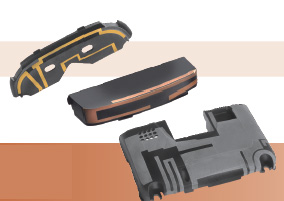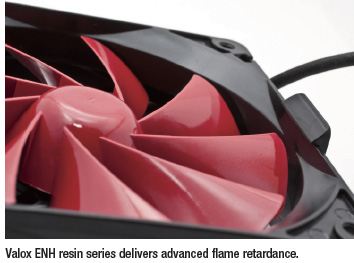
The electrical and electronics sector demands highly specialised materials to support their functions in today's demanding market. With present preference for lightweight, environmentfriendly and highly durable electronics, engineering plastics manufacturers are racing to launch new compounds to suit these requirements. Mitsubishi Engineering-Plastics has extended its Laser Direct Structuring (LDS) materials portfolio by introducing two new grades recently. XANTAR® LDS 3720 was specifically developed to show very good practical impact performance, suitable for use in mobile phone covers or housings, and XANTAR® LDS 3730, which is the first halogen-free flame retardant LDS grade is used to create antennas in laptops and notebooks. They join XANTAR® LDS 3710 which was used as the first LDS materials to create a mobile phone antenna and have since provided Mitsubishi Engineering-Plastics with a proven track record of quality and performance in antenna systems applications. The two new grades have already been approved and are being used by several major mobile phone and laptop producers. "Mitsubishi Engineering-Plastics has boosted LDS technology in the portable electronics segment by creating a close triangular communication loop between our customers, our business developers and our product developers. This communication concept enables us to create LDS solutions proactively and/or at very short notice, fulfilling the needs of our customers since a short time to market is key for their success," according to Mr. Hans Guns, Business Manager at Mitsubishi Engineering-Plastics.
Market trends in new application areas According to Dr. Ir. Bernard Schrauwen, Product Developer of XANTAR® LDS materials at Mitsubishi Engineering-Plastics, "Laser and metallisation behaviour, good mechanical properties, surface appearance and radio frequency properties are essential criteria for the successful development of new LDS materials. In addition, extending into new application areas, such as antennas in laptops and notebooks, requires additional material properties including flame retardant behaviour." Diversification, styling, miniaturisation and cost reduction are trends in portable electronics. At the same time, end-users do expect an increased number of novel functions available inside trend-looking covers and the amount of antennas in these devices is increasing. LDS is becoming increasingly popular as the MID technology to produce these antennas, especially for mobile phones. "Most of the mobile phone producers have chosen to use the LDS technology for the antenna's in their smartphones. The reason for this is that the 3D design freedom of the LDS technology and possibility to create circuits on curved parts with low wall thickness enables antenna producers to integrate the antenna in existing parts such as covers and frames." says Mr. Francis van Vehmendahl, Business Development Manager for XANTAR® LDS materials.

The comprehensive XANTAR portfolio comprises all common types of polycarbonate, specialised in their diversity and customisation to specific market requirements. XANTAR C blends of PC/ABS and XANTAR E (PC/Polyester) extend the scope while maintaining the same high quality standards of XANTAR products. The superior properties and processability of XANTAR C grades, and new material innovations such as XANTAR LDS, XANTAR AM and XANTAR XRM provide particular value in applications where its quality helps customers met higher-than-normal quality demands. The portfolio provides superior mechanical and processing properties, enhanced long-term stability, shot-to-shot and lot-to-lot consistency, and feature halogen-free flame retardant grades as well as excellent base colour and colour stability. These are ideal for such applications as high-end battery cases for uninterru
Air Jordan 1 The electrical and electronics sector demands highly specialised materials to support their functions in today's demanding market. With present preference for lightweight, environmentfriendly and highly durable electronics, engineering plastics manufacturers are racing to launch new compounds to suit these requirements. Mitsubishi Engineering-Plastics has extended its Laser Direct Structuring (LDS) materials portfolio by introducing two new grades recently. XANTAR® LDS 3720 was specifically developed to show very good practical impact performance, suitable for use in mobile phone covers or housings, and XANTAR® LDS 3730, which is the first halogen-free flame retardant LDS grade is used to create antennas in laptops and notebooks. They join XANTAR® LDS 3710 which was used as the first LDS materials to create a mobile phone antenna and have since provided Mitsubishi Engineering-Plastics with a proven track record of quality and performance in antenna systems applications. The two new grades have already been approved and are being used by several major mobile phone and laptop producers. "Mitsubishi Engineering-Plastics has boosted LDS technology in the portable electronics segment by creating a close triangular communication loop between our customers, our business developers and our product developers. This communication concept enables us to create LDS solutions proactively and/or at very short notice, fulfilling the needs of our customers since a short time to market is key for their success," according to Mr. Hans Guns, Business Manager at Mitsubishi Engineering-Plastics. Market trends in new application areas According to Dr. Ir. Bernard Schrauwen, Product Developer of XANTAR® LDS materials at Mitsubishi Engineering-Plastics, "Laser and metallisation behaviour, good mechanical properties, surface appearance and radio frequency properties are essential criteria for the successful development of new LDS materials. In addition, extending into new application areas, such as antennas in laptops and notebooks, requires additional material properties including flame retardant behaviour." Diversification, styling, miniaturisation and cost reduction are trends in portable electronics. At the same time, end-users do expect an increased number of novel functions available inside trend-looking covers and the amount of antennas in these devices is increasing. LDS is becoming increasingly popular as the MID technology to produce these antennas, especially for mobile phones. "Most of the mobile phone producers have chosen to use the LDS technology for the antenna's in their smartphones. The reason for this is that the 3D design freedom of the LDS technology and possibility to create circuits on curved parts with low wall thickness enables antenna producers to integrate the antenna in existing parts such as covers and frames." says Mr. Francis van Vehmendahl, Business Development Manager for XANTAR® LDS materials.
The electrical and electronics sector demands highly specialised materials to support their functions in today's demanding market. With present preference for lightweight, environmentfriendly and highly durable electronics, engineering plastics manufacturers are racing to launch new compounds to suit these requirements. Mitsubishi Engineering-Plastics has extended its Laser Direct Structuring (LDS) materials portfolio by introducing two new grades recently. XANTAR® LDS 3720 was specifically developed to show very good practical impact performance, suitable for use in mobile phone covers or housings, and XANTAR® LDS 3730, which is the first halogen-free flame retardant LDS grade is used to create antennas in laptops and notebooks. They join XANTAR® LDS 3710 which was used as the first LDS materials to create a mobile phone antenna and have since provided Mitsubishi Engineering-Plastics with a proven track record of quality and performance in antenna systems applications. The two new grades have already been approved and are being used by several major mobile phone and laptop producers. "Mitsubishi Engineering-Plastics has boosted LDS technology in the portable electronics segment by creating a close triangular communication loop between our customers, our business developers and our product developers. This communication concept enables us to create LDS solutions proactively and/or at very short notice, fulfilling the needs of our customers since a short time to market is key for their success," according to Mr. Hans Guns, Business Manager at Mitsubishi Engineering-Plastics. Market trends in new application areas According to Dr. Ir. Bernard Schrauwen, Product Developer of XANTAR® LDS materials at Mitsubishi Engineering-Plastics, "Laser and metallisation behaviour, good mechanical properties, surface appearance and radio frequency properties are essential criteria for the successful development of new LDS materials. In addition, extending into new application areas, such as antennas in laptops and notebooks, requires additional material properties including flame retardant behaviour." Diversification, styling, miniaturisation and cost reduction are trends in portable electronics. At the same time, end-users do expect an increased number of novel functions available inside trend-looking covers and the amount of antennas in these devices is increasing. LDS is becoming increasingly popular as the MID technology to produce these antennas, especially for mobile phones. "Most of the mobile phone producers have chosen to use the LDS technology for the antenna's in their smartphones. The reason for this is that the 3D design freedom of the LDS technology and possibility to create circuits on curved parts with low wall thickness enables antenna producers to integrate the antenna in existing parts such as covers and frames." says Mr. Francis van Vehmendahl, Business Development Manager for XANTAR® LDS materials.  The comprehensive XANTAR portfolio comprises all common types of polycarbonate, specialised in their diversity and customisation to specific market requirements. XANTAR C blends of PC/ABS and XANTAR E (PC/Polyester) extend the scope while maintaining the same high quality standards of XANTAR products. The superior properties and processability of XANTAR C grades, and new material innovations such as XANTAR LDS, XANTAR AM and XANTAR XRM provide particular value in applications where its quality helps customers met higher-than-normal quality demands. The portfolio provides superior mechanical and processing properties, enhanced long-term stability, shot-to-shot and lot-to-lot consistency, and feature halogen-free flame retardant grades as well as excellent base colour and colour stability. These are ideal for such applications as high-end battery cases for uninterruAir Jordan 1
The comprehensive XANTAR portfolio comprises all common types of polycarbonate, specialised in their diversity and customisation to specific market requirements. XANTAR C blends of PC/ABS and XANTAR E (PC/Polyester) extend the scope while maintaining the same high quality standards of XANTAR products. The superior properties and processability of XANTAR C grades, and new material innovations such as XANTAR LDS, XANTAR AM and XANTAR XRM provide particular value in applications where its quality helps customers met higher-than-normal quality demands. The portfolio provides superior mechanical and processing properties, enhanced long-term stability, shot-to-shot and lot-to-lot consistency, and feature halogen-free flame retardant grades as well as excellent base colour and colour stability. These are ideal for such applications as high-end battery cases for uninterruAir Jordan 1
 iConnectHub
iConnectHub
 Login/Register
Login/Register Supplier Login
Supplier Login


























